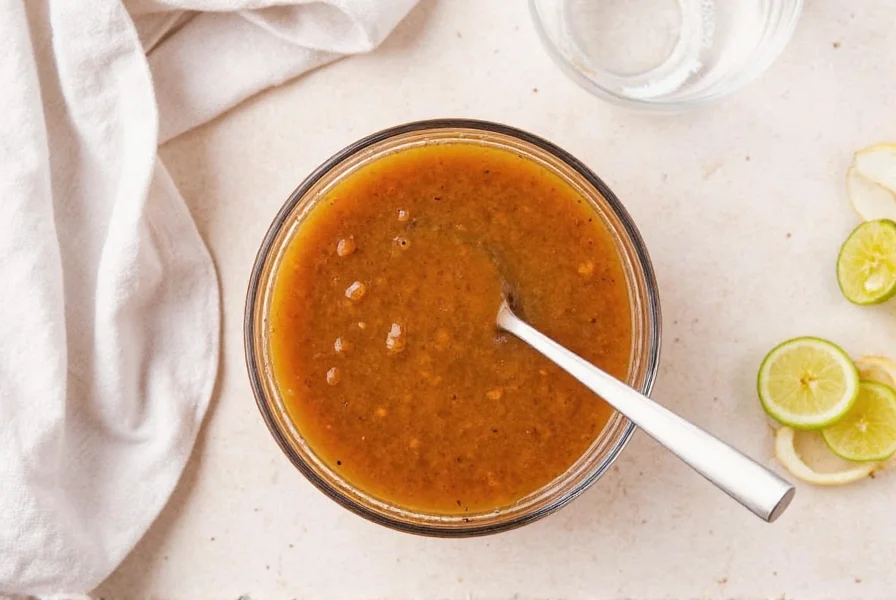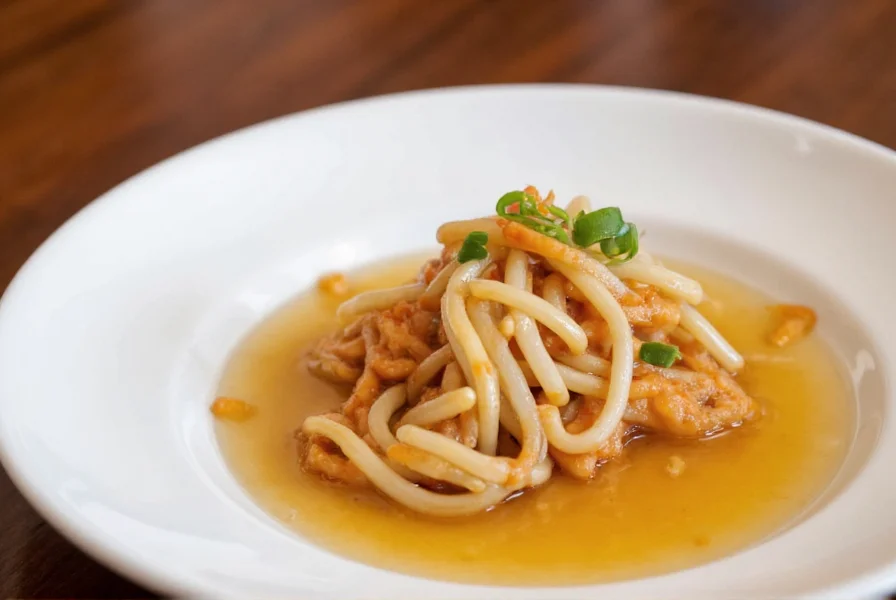Hibachi ginger sauce forms the backbone of Japanese-style teppanyaki cooking, delivering that unmistakable flavor profile you experience at hibachi restaurants. Unlike standard ginger sauces, the hibachi version incorporates specific ratios of ingredients that create a complex flavor profile perfect for high-heat cooking methods.
Understanding Hibachi Ginger Sauce Components
The magic of authentic hibachi ginger sauce lies in its carefully balanced ingredients. While recipes vary among chefs, the core components remain consistent across traditional preparations. This isn't merely a ginger sauce—it's a culinary symphony where each ingredient plays a specific role in creating that restaurant-quality taste.
| Essential Ingredient | Function in Sauce | Professional Ratio |
|---|---|---|
| Fresh ginger (minced) | Provides signature heat and aromatic base | 3 parts |
| Soy sauce | Delivers umami depth and saltiness | 4 parts |
| Rice vinegar | Creates bright acidity that cuts through richness | 2 parts |
| Granulated sugar | Counterbalances acidity with subtle sweetness | 1.5 parts |
| Garlic (minced) | Adds aromatic complexity | 1 part |
Creating Authentic Homemade Hibachi Ginger Sauce
While many seek "hibachi ginger sauce near me" for restaurant versions, crafting it at home yields superior freshness and customization. The process requires attention to ingredient quality and proper emulsification techniques that many simplified recipes overlook.

Professional-Grade Recipe
Follow these precise steps for restaurant-quality results:
- Combine 1 cup soy sauce, ½ cup rice vinegar, and ⅓ cup sugar in a saucepan
- Add 3 tablespoons freshly grated ginger and 1 tablespoon minced garlic
- Whisk in 2 tablespoons sesame oil and 1 teaspoon crushed red pepper flakes
- Simmer gently for 8-10 minutes until slightly thickened
- Cool completely before storing
This "homemade hibachi ginger sauce recipe" produces approximately 1.5 cups of sauce with the proper viscosity for both marinating and drizzling. The simmering process is crucial—it melds the flavors while preserving the ginger's bright character without becoming overly sharp.
Hibachi Ginger Sauce vs Regular Ginger Sauce
Many confuse standard ginger sauce with authentic hibachi versions. The key differences lie in texture, flavor balance, and intended use:
- Hibachi ginger sauce contains higher vinegar content for better high-heat performance and includes sesame oil for nutty depth
- Traditional ginger sauce often relies more heavily on sweeteners and lacks the vinegar-soy balance needed for teppanyaki cooking
- Restaurant hibachi sauce typically includes small amounts of mirin and MSG for enhanced umami—elements easily replicated at home
Understanding "what is hibachi ginger sauce made of" reveals why it performs better on the grill than standard ginger sauces. The higher acid content helps tenderize proteins while preventing burning during high-temperature cooking.
Optimal Usage Techniques
Mastering "how to make hibachi ginger sauce from scratch" is only half the battle—proper application determines final results:
- As a marinade: Use for 30-90 minutes on proteins (longer risks texture breakdown from acidity)
- During cooking: Apply midway through grilling for caramelization without burning
- Finishing sauce: Drizzle cooled sauce over completed dishes for brightest ginger flavor
- With fried rice: Add 2-3 tablespoons per serving during final cooking stage for "best hibachi ginger sauce for fried rice" results
Storage and Shelf Life Considerations
Proper storage maintains flavor integrity. Follow these "hibachi ginger sauce storage tips" for maximum freshness:
- Store in airtight container in refrigerator for up to 3 weeks
- Freeze in ice cube trays then transfer to bags for 3-month storage
- Always use clean utensils to prevent contamination
- Shake well before each use as natural separation occurs
Unlike commercial versions with preservatives, homemade sauce lacks stabilizers. The fresh ginger content means flavor peaks at 5-7 days before gradually mellowing—this "hibachi ginger sauce shelf life" knowledge helps time preparation for optimal taste.
Troubleshooting Common Issues
Even experienced cooks encounter challenges with "hibachi ginger sauce ingredients" ratios:
- Too salty: Balance with additional sugar and rice vinegar (1:1 ratio)
- Overpowering ginger: Dilute with additional soy sauce base
- Too thin: Simmer additional 2-3 minutes or add cornstarch slurry
- Bitter after cooking: Reduce simmer time and add ½ teaspoon mirin
These adjustments address the most frequent problems encountered when attempting to recreate authentic restaurant-style sauce at home. Remember that ingredient quality directly impacts final results—fresh ginger dramatically outperforms powdered alternatives in "authentic Japanese hibachi ginger sauce" preparations.
Frequently Asked Questions
Can I substitute rice vinegar in hibachi ginger sauce?
Yes, but with caveats. Apple cider vinegar makes the closest substitute (use ¾ the amount), while white vinegar requires dilution with water (1:1 ratio). Avoid balsamic or red wine vinegars as they alter the color and flavor profile significantly. For authentic taste, rice vinegar remains essential in traditional hibachi ginger sauce recipes.
Why does my homemade hibachi ginger sauce taste different from restaurants?
Restaurant versions often include small amounts of MSG (½ teaspoon per cup) and mirin (1 tablespoon per cup) that enhance umami without being detectable as separate flavors. The high-heat cooking surface also caramelizes the sauce differently than home stovetops. For closest replication, add ½ teaspoon MSG and use a cast-iron grill pan at maximum heat when cooking with the sauce.
Is hibachi ginger sauce gluten-free?
Traditional hibachi ginger sauce contains soy sauce, which includes wheat. For gluten-free versions, substitute tamari or certified gluten-free soy sauce. Verify all ingredients as some commercial ginger sauces contain wheat-based thickeners. When making "homemade hibachi ginger sauce recipe" from scratch with gluten-free soy alternatives, the result is naturally gluten-free.
How can I make hibachi ginger sauce less sweet?
Reduce sugar by 25% and compensate with additional rice vinegar (1 teaspoon per tablespoon sugar removed) to maintain balance. For "hibachi ginger sauce vs regular ginger sauce" comparisons, authentic versions are less sweet than Americanized interpretations. Adding ¼ teaspoon citrus zest can enhance perceived sweetness without additional sugar.
What's the best oil to use in hibachi ginger sauce?
Toasted sesame oil provides the most authentic flavor (1-2 tablespoons per cup), but its low smoke point limits high-heat cooking. For grilling applications, combine 1 part sesame oil with 3 parts high-heat oil like avocado or grapeseed. This "hibachi ginger sauce ingredients" adjustment maintains flavor while preventing burning during teppanyaki-style cooking.
Mastering hibachi ginger sauce opens doors to authentic Japanese teppanyaki experiences at home. By understanding the precise ingredient ratios, cooking techniques, and storage requirements, you can consistently recreate that distinctive restaurant-quality flavor. Whether you're searching for "hibachi ginger sauce ingredients" or perfecting your "homemade hibachi ginger sauce recipe," attention to these details transforms ordinary meals into extraordinary culinary experiences.











 浙公网安备
33010002000092号
浙公网安备
33010002000092号 浙B2-20120091-4
浙B2-20120091-4